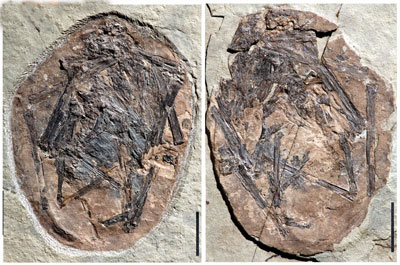Tiny pterosaur’s untimely end

This fossil egg (at left) of a pterosaur (flying reptile) is 53 mm (2.08 in) long and 41 mm (1.61 in) across. The pterosaur’s folded wings, tucked compactly inside the egg, give the embryo a wingspan of 27 cm (10½ in). Had it lived, researchers say that the embryo would have grown into a ‘medium-to-large pterosaur’, i.e. with a likely wingspan between three and six metres (10–20 ft).
Credit: Fossil egg part and counterpart photos provided by Xiao-Lin Wang and Zhong-He Zhou
Although fossilized dinosaur embryos are found all over the world, no-one had ever reported finding a pterosaur embryo … until now. A recent report in Nature describes a fossil embryo that is ‘unambiguously a pterosaur … enjoying its last few days in the egg’.1

Unearthed in Liaoning, China, the fossil shows details of the ‘exquisitely preserved’ embryonic skeleton in its egg, thus confirming that pterosaurs were indeed egg-layers. Incredibly, wing membrane fibres and large patches of skin imprints are also preserved.
‘Preservation of such delicate tissues with the skeleton and eggshell probably indicates the embryo was killed and deposited quickly as a result of a natural disaster, such as a volcanic eruption’, say the researchers.
But which disaster? Surely the global Flood of Noah’s time (Genesis 6–9) would explain why we find mass deposits of fossils, many ‘exquisitely preserved’, indicating rapid burial, right around the world.
Reference
- Wang, X. and Zhou, Z., Pterosaur embryo from the Early Cretaceous, Nature 429(6992):621, 2004. Return to text.





Readers’ comments
Comments are automatically closed 14 days after publication.